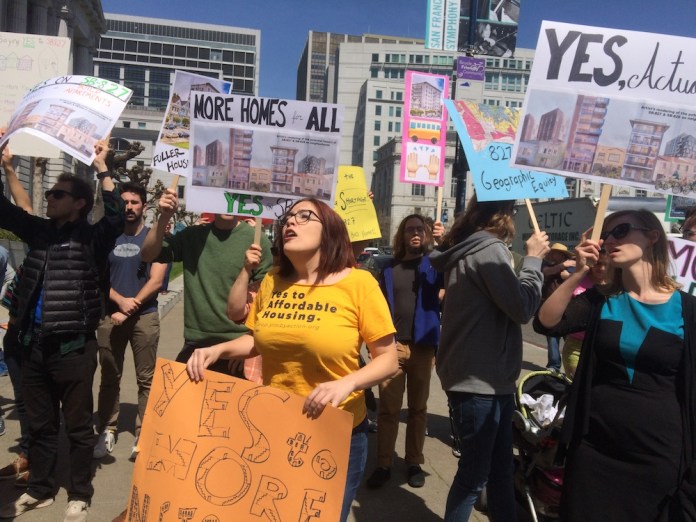California's Housing Crisis is Heating Up!
BY SIERRA LEWANDOWSKI 
On April 17, Senate Bill 827 - a housing bill introduced by California Senator Scott Wiener - failed by a vote of 4-6 in the committee on Transportation and Housing. SB 827 sought to increase housing densification across the state by loosening local restrictions on height limits and parking minimums. Overriding certain housing restrictions would allow for the possibility of increased development within a quarter to a half mile of major “transit rich” centers and bus hubs. SB 827’s failure leaves questions of upzoning, sustainability, transportation access, and housing affordability unanswered. California struggles to find solutions to some of the state’s most pressing issues.
Supporters of SB 827 recognize its necessity while California remains in the midst of a devastating housing crisis. As demand for housing in the state continues to escalate, individuals are being uprooted from their communities and forced to seek alternative options further and further away from urban centers. SB 827 also gained traction from those who recognize its potential environmental impacts as a necessary step towards meeting California’s climate change initiatives. Increased housing near transit centers could reinvigorate transit use, while lessening the dependency of individual commuters on automobiles. If the solution to California’s housing epidemic is to merely increase housing supply, this bill aggressively does just that.
Despite the fervor SB 827 conjured, and with the understanding that a revitalization of our cities is necessary to address California’s endemic housing calamity - as put by Sen. Mike McGuire - “we also have to get it right.” The scope of SB 827 was undoubtedly the leading factor in its failure with the Senate Transportation and Housing committee.The bill poses a severe threat to localized control by imposing a unified, one-size-fits-all solution to individual city ordinances and zoning laws across the state.
Analysis by the San Francisco Planning Department suggest that this bill would effectively impact “basically all” localized zoning in San Francisco and “huge swaths” in Los Angeles. Some fear that the area “within a half mile of regional transit centers” and a “three quarter mile near frequented bus stops” is too arbitrary, which could lead to development in areas not able to support the upzoning. While some concerns of SB 827’s state-wide reach remain universal, much of the bill’s opposition falls into two distinct factions.
The first, raise concern about increasing population density and disruptive construction resulting from the proposed upzoning. This opposition is characteristic of particularly wealthy counties - like Marin, Palo Alto and Beverly Hills - that fear depreciated home values and the possibility of losing the “character ”of their cities with increasing cultural, economic and racial diversity.
Ironically, this majority-opposition seem to be outspokenly “progressive liberals” who vocalize their desire to serve working-class populations, until it “endangers” their backyards. Most aptly, this group of opposition seemingly “co-opt the language of gentrification” to effectively reduce the possibility of diversity in their communities and to uphold the economically and racially segregated communities they currently enjoy.
The alternative source of opposition comes from affordable housing advocates throughout the state. Many opposers recognize the inherent limits and exclusions within SB 827. As the influx of tech wizards, Soul Cycles, and eclectic juice shops continue to disrupt the ecosystems of our cities, displacement has become commonplace.
Many vocalize their opposition to this bill by citing its original drafter, the founder of Yes in My Backyard (YIMBY), Brian Hanon. YIMBYs remain pro-development and inevitably, pro-gentrification. As such, the crux of this SB 827 opposition is the lack of protective measures for working-class communities, those most affected by increasing development and in desperate need of affordable housing options. For example, SB 827 outlines that projects offering 10-25 residential units, must provide 5 percent of those households to be accessible for “very low income” individuals. In practice, this would mean half of a ten unit building would constitute affordability, or, in the case of 25, one and a quarter apartments.
As prices and standards of living continue to soar across the state, debates over market-rate development and rent control are of a particularly divisive nature. Berkeley city Mayor Jesse Arreguín outed this bill as a “declaration of war against our neighborhoods” highlighting SB 827’s inherent benefits to private developers at the direct and targeted expense of working-class (and disproportionately communities of color), by pricing them out of their own homes.
We need more housing in California and SB 827 has initiated an important conversation. As opposition to the bill remains widespread- stemming from California’s city elite to its most vulnerable tenants- it is likely that housing reform must be both incremental and localized. Sen. Wiener is predicted to propose future iterations of this bill, meaning the failure of SB 827 represents only the beginning of a long housing debate within the California legislative. It remains unclear how the factioned oppositions will join together in pursuit of a livable California for all. For now, hold onto your seats, and your rent-controlled housing, Californians.